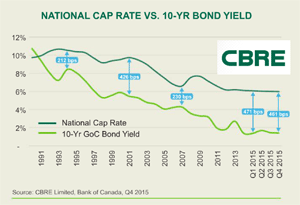Continued low interest rates are expected to contribute to Canadian commercial real estate (CRE) remaining an attractive investment in 2016 despite ongoing challenges imposed by the broader economy.
 “Clearly there are pockets of concern throughout the country, but overall conditions remain pretty good,” said Paul Morassutti, CBRE Canada’s executive vice-president of valuation and advisory services, who contributed to the real estate company’s Canadian Cap Rates & Investment Insights Q4 2015 report.
“Clearly there are pockets of concern throughout the country, but overall conditions remain pretty good,” said Paul Morassutti, CBRE Canada’s executive vice-president of valuation and advisory services, who contributed to the real estate company’s Canadian Cap Rates & Investment Insights Q4 2015 report.
“I think the market has really been quite resilient.”
Cap rates remain relatively stable across most cities and asset classes, and top-performing properties should see their rates contract this year. The spread between the six per cent national average cap rate and the 1.39 per cent rate for 10-year Government of Canada bonds rose by six basis points to 461 basis points in the fourth quarter.
“Capital is seeking safety and security, and hard assets provide that,” said Morassutti. “You could argue that in times like this, when the rest of the world seems to be blowing up and stock markets are short-circuiting, real buildings with real tenants and long-term leases have even greater appeal to buyers.”
Vancouver a resilient market
The Vancouver market continues to gain momentum and strong demand will maintain investment volumes and support record low cap rates. New office space came on the market and the city’s vacancy rate rose slightly, though that hasn’t scared off foreign or domestic investors.
“For the past 25 years, it has been one of the safest and least volatile and most resilient real estate markets in the world,” said Morassutti. “I’d put it up there with London and Manhattan in terms of stability to preserve capital and demand for product.”
Morassutti believes Toronto commercial real estate will also remain attractive to investors by virtue of the size of the market, although there are large fluctuations in its performance depending on area.
He cites average office vacancy rates of about five per cent for class-A office buildings downtown and one per cent in the south core, the area with most of the new office construction. At the same time, some pockets in the suburbs are experiencing vacancy rates of close to 30 per cent.
Hotels in Toronto and Vancouver remain strong, with lower cap rates for downtown full-service hotels.
Alberta hit hard by low oil prices
Toronto and Vancouver also benefited from capital fleeing Alberta due to continuing low oil prices, and the Wild Rose province is poised for more problems this year — particularly the downtown office sectors in Calgary and, to a lesser extent, Edmonton.
“That’s due to the unfortunate timing of new supply coming on stream at the exact time that demand is clearly declining,” said Morassutti. “The result is what we see today, which is vacancies going up almost every month.”
While this should hypothetically cause cap rates to rise, there’s been little movement due to a large bid-ask spread as owners of top properties are taking long-term views instead of dumping them at fire sale rates.
“The Brookfields, the Bentalls, the Oxfords and the Cadillac Fairviews of the world have no intentions of selling any of their product in this type of market,” said Morassutti.
“We’re very well-positioned in Canada with extremely strong ownership. We haven’t added too much new supply and we’re not overleveraged as an industry.”
Morassutti points out quality retail, industrial and multi-residential properties in Alberta have held up better than most people realize. For the most part, that also applies across the rest of the country.
“If I had to pick sectors that are going to struggle a bit, I’d say power centres in secondary markets or power centres that still have Target vacancies,” said Morassutti.
Other Canadian markets
Meanwhile, slower trading and minimal cap rate movement characterized the fourth quarter in Montreal, while the scarcity of high-quality product maintained tight yields for all property types in core areas. Mid-sized development sites continue to receive strong interest from a broad range of investors.
The change of federal governments has injected a renewed sense of optimism in the Ottawa commercial real estate market, which is expected to enhance liquidity. Pent-up demand for core downtown office buildings should continue.
Institutional buyers are actively pursuing opportunities in Waterloo Region, including the 26-acre former Maple Leaf Foods infill site in downtown Kitchener. There’s been a flurry of development and land purchases along the 19-kilometre light rail transit line being built from Waterloo’s Conestoga Mall to Kitchener’s CF Fairview Mall.
The region continues to offer enhanced returns compared to other Canadian markets, with the cap rate differential for quality properties hitting 100 basis points in some cases.
A number of new office projects were completed in Halifax in late 2015, and more are expected this year, which will put upward pressure on vacancy rates. Urban residential development sites were in demand last year, with record pricing for well-located sites.







